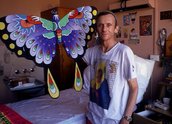

Sadness (1999)
Synopsis
The documentary Sadness is based on a theatrical performance developed by the award-winning Australian photographer William Yang. Writer-director Tony Ayres developed it into a film with Yang as the central character. Yang is covering two main stories linked through the experience of loss and death. His photographs of gay friends and lovers portray their journey from leading healthy full lives to succumbing to the devastating symptoms of AIDS. The pictorial record of these harrowing changes is intercut with Yang’s own mission to uncover the truth behind a family murder.
Curator’s notes
William Yang appeared in Tony Ayres’s previous documentary China Dolls (1997), made two years prior. That documentary pre-empted the visual style that Ayres uses to great effect in this collaboration with Yang. Yang’s performance was based on a monologue which he combined with photographs taken over the years of friends and family. Yang chose photographs to tell the stories of several gay men who had subsequently died of AIDS. Yang’s portraits begin with vibrant happy men followed by harrowing images as their diseases take hold and finally kill them. At the same time Yang tells a story of travelling to his early childhood home to investigate the death of a great uncle who, his mother suggests, was murdered.
At first there seems no connection between the two strands, other than Yang himself, but by the end of the film both stories have come together. While the visual elements of the story are extremely strong, the power of the documentary lies in these parallel stories that together explore the meaning of life, love and death. And although the film is a meditation on sadness and loss it is delivered without nostalgia or sentiment.
The success of the filmmaking lies in the power of William Yang’s portraits of friends and family but also in the deadpan delivery of his monologue which allows us to share in his relationships with friends and lovers and travel with him as he searches for his hidden family history. Ayres films William Yang looking straight into the camera. When Yang tells of his investigation of the murder of his great uncle, it gives Sadness the feel of a road movie.
As in China Dolls, director Ayres uses many visual and sound effects. The travelling shots as Yang hits the road are often done in studio with back projection – a reference to an earlier style of Hollywood filmmaking frequently used by Alfred Hitchcock. The dramatic re-creations of Yang’s great uncle’s murder are studio-based and very stylised. The effective use of actors and the dramatisation signals Tony Ayres’s move into dramatic features (see Walking on Water, 2002 and The Home Song Stories, 2007). However Ayres does not embellish Yang’s photographs of his dead friends and family and these powerful portraits are documented without unnecessary adornment by the filmmaker.
Sadness was a great success with audiences and critics and won many awards. For some this was surprising, given the subject matter, and is a tribute to the confident way Yang and Ayres handled the material which could be seen as ‘too hard’ or ‘too depressing’ for an audience. Risky too is combining two seemingly unrelated stories. However Ayres and his producers, Michael McMahon and Megan McMurchy, and editor Riva Childs, have managed to set exactly the right tone. The film ends with Yang sharing his understanding of what sadness and the common experience of grief can teach us.
The use of music is also incredibly important to the reading of the film and how we respond to it. It is sometimes light, sometimes mellow and at the end there is just silence as we meditate on the portraits of the people we have met. There is no hint of sentimentality and we don’t feel manipulated by Yang or the filmmakers. Instead there is a feeling of gratitude for taking us on a journey that explores the themes of life and death, memory and love as a way to understand personal identity and loss.
Sadness screened on SBS on 14 November 1999. Among the awards it won were Best Documentary from the Film Critics’ Circle of Australia and the Film Victoria Erwin Rado Award for Best Australian Short.
- Overview
- Curator’s notes
- Video 2 clips
- Principal credits
- Find a copy
- Make a comment
- Map
- Add your review



